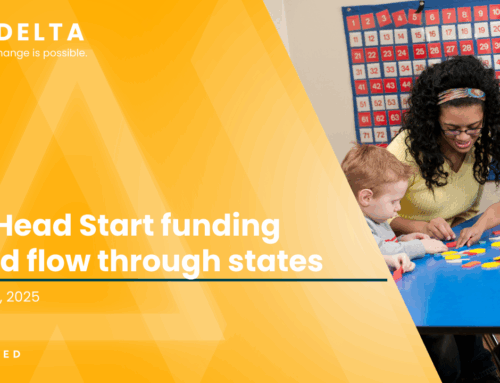The Delta Issue #33
The phones are winning in the classroom. What do we do now?
Hi friends, Jessica Baghian here. Let’s talk about kids and their phones.
As we process the latest NAEP results and think seriously about what it will take to reverse learning declines, we can’t ignore one of the most obvious daily distractions: phones.
More than half of public school leaders say cell phones are actively hurting academic performance. Between Jonathan Haidt’s interview on the Ezra Klein Show, a wave of new state legislation, and headlines like this one from the LA Times, it’s clear: parents, educators, and lawmakers are all asking the same thing — how do we reduce the harm phones are causing in schools?
So this week, we’re breaking down what we’re seeing, what’s working (and what’s not), and what educators can do next.
Bottom line: Cell phones are a problem in schools
Anyone who has walked into a school lately knows they’re filled with students TikTok scrolling, meme sharing, and ChatGPT searching.
We spend a lot of time talking about instructional quality and making sure students have access to strong curriculum, as we should. But none of it matters if students are distracted, disengaged, and buried in their phones. Teens now spend the equivalent of a full-time job, 40 hours a week, on their devices. Every minute spent scrolling is a minute not engaged with the classroom, and those minutes add up.
That’s alarming, especially when students are already facing historic learning loss from the pandemic and a decade-long decline in achievement.
We also know that phones don’t just eat up learning time — they affect how kids show up to school in the first place. Since the early 2010s, adolescent rates of anxiety, depression, and self-harm have all skyrocketed — especially among girls. Around that same time, academic performance started to decline — NAEP and PISA scores that had been slowly improving for years suddenly dropped. All signs point to the same shift: the rise of smartphones and social media in teens’ daily lives.
Phones are fundamentally reshaping how kids experience school, friendship, and even their sense of self.
Bans are here. But implementation is messy.
States are moving fast to curb cell phone use in schools. Since Florida’s statewide ban passed last year, eight more have followed. And in LAUSD, more than 250 schools now use magnetic pouches to restrict access during the day.
In most districts with limits on cell phone use, the early signs are promising. Teachers are reporting more focus in class, students are actually talking to each other at lunch, and principals are seeing fewer fights and fewer distractions.

But just like any major policy change, the success of a cell phone ban doesn’t come from passing the policy at the state house, it comes from how it’s implemented in the classroom.
Students are smart, and they will find loopholes. They’re already slipping dummy phones into pouches, sneaking in second devices, and watching YouTube tutorials on how to crack them open. So now, principals, parents, and educators are asking:
- Who enforces the policy: teachers, security, administrators?
- What happens when a student refuses or breaks the rules?
- How do we make sure families can still reach their kids in an emergency?
- What about students with medical needs or other exceptions?
Simply banning cell phones won’t get them out of students’ hands. We need clear roles, realistic protocols, and buy-in from everyone involved in the implementation chain, including students themselves.
Pilot first. It won’t be perfect on the first try. In Arkansas, the state launched a pilot with districts that wanted to go phone-free, using the first year to figure out what worked, where the friction points were, and how to improve before scaling. For other states wanting to follow suit: start small, measure what matters, then adjust and improve.
Get buy-in from teachers, parents, and students
Support teachers. If we want teachers to help enforce cell phone policies on top of everything else they’re juggling, they need three things: a clear, consistent school-wide protocol, training on how to apply it, and real support from school leaders when they face roadblocks.
Bring parents in. Parents want their kids to focus in class, but they also want to know they can reach them, especially in an emergency. I struggle with this personally because my son has Type 1 diabetes and I worry if I can’t reach him. If you want a phone policy to stick, you have to communicate with families early and clearly. Explain the “why,” give them an alternative way to get in touch with their child during the day, and be upfront about how the school will handle exceptions for emergencies, medical needs, or other urgent issues.
Get student buy-in — because many of them want this too. Polling shows around half (50-54%) of teens are worried about their own screen time and the toll on their mental health. Many students want a break — they just don’t want to be the lone kid without a cell phone.
That’s why it’s a mistake to treat students as obstacles to implementation when they can be some of the most important partners in making it work. School and district leaders can solicit student input on cell phone policies by carving out real space for student voices through surveys, town halls, and student advisory councils.
Kids can handle more responsibility than we often give them credit for, including around their phone use. But just like us, they need a reason to care, and a role in making the change.
Let’s Get Muddy
You can have a role in this change, too. A nonpartisan group of academic researchers, led by Angela Duckworth at the University of Pennsylvania, recently launched a national survey that seeks to gather information from public school teachers, principals, and other personnel about cell phone policies and their impact on student achievement and well-being. If you are a public school educator, please consider taking this 5-minute survey to help them gather more data about what works.




